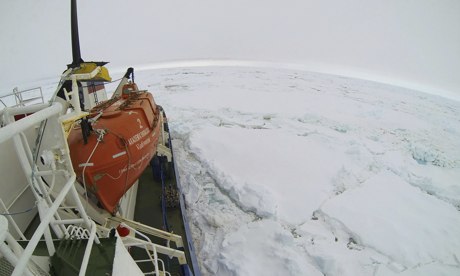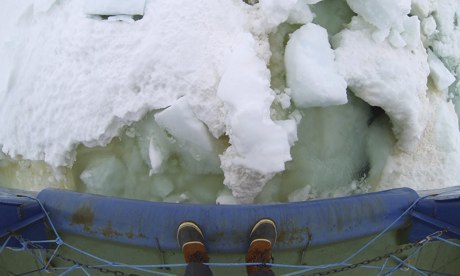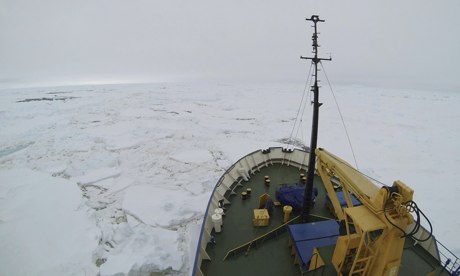A team of scientists and members of the public who have been retracing the footsteps of the Australasian Antarctic Expedition (AAE) of 1911 have become trapped in heavy ice a few miles from the coast of Antarctica.
Passengers aboard the ship, the MV Akademik Shokalskiy, were informed on Christmas morning that the captain had issued a distress call to the Maritime Service Authority based in Falmouth in the UK earlier in the day. Three nearby icebreaker ships have been notified of the Shokalskiy's situation and are on their way to help.
The nearest ship, the Chinese Xue Long (Snow Dragon), will take just over a day to reach the Shokalskiy's position, around 1,500 nautical miles from Hobart in Tasmania. A French ship called the Astrolabe, and sent out from the nearest Antarctic base, Dumont D'Urville, could arrive around the same time. The furthest ship, also on its way, is the Australian icebreaker, Aurora Australis.
"The ship is no danger," said Chris Turney. "We're currently in heavy ice and we need help to get out. It's frustrating - we're only two miles from open water. Everyone is well on board and morale is high. We've had a fantastic Christmas and the science programme has been continuing while we're stuck in position. The results looking really exciting. We're very fortunate the Chinese are in the area, passing relatively close by."
The Snow Dragon is a 166-metre-long icebreaker, cruising towards the Shokalskiy at 14.5 knots.
The Russian-built Shokalskiy left the port of Bluff in New Zealand on 8 December with 48 passengers and 20 crew members to follow in the footsteps of the great Antarctic explorer and scientist Douglas Mawson. Led by the climate scientist Chris Turney of the University of New South Wales, the ship has been sailing through the Southern Ocean, repeating and extending many of Mawson's wildlife and weather observations in order to build a picture of how this part of the world has changed in the past 100 years.
The expedition had already reached the fast ice off Commonwealth Bay, carrying out measurements of the Southern Ocean along the way. A small team of scientists and conservationists also reached Mawson's Huts at Cape Denison on Thursday last week, 40 miles (65km) across the ice from where the ship was anchored. The expedition was heading east on Tuesday to spend a day at the Mertz glacier when it became trapped among thick ice floes near Stillwell Island, off Cape de la Motte.
A spokeswoman for the Australian Maritime Safety Authority, which is co-ordinating the rescue, said: "It's in quite a remote part of the world. But we have everyone safe. The vessel isn't in any immediate danger."
Passengers were kept updated throughout the day about the ship's situation. When the ship is free from the ice, expected by the weekend, this modern incarnation of the AAE will continue on to the Southern Ocean and will return to Bluff via a stop on Macquarie Island to carry out a short programme of wildlife, oceanography and climate research.
"We can't wait to get to Macquarie Island," said Turney. "It was a cornerstone of the original AAE and we're keen to finish the research programme there."






Comment: The ice breaker transporting a research team led by Chris Turner, author of a Time article titled "We must acknowledge global warming, and act" has been unexpectedly trapped in Antartica ice for days.